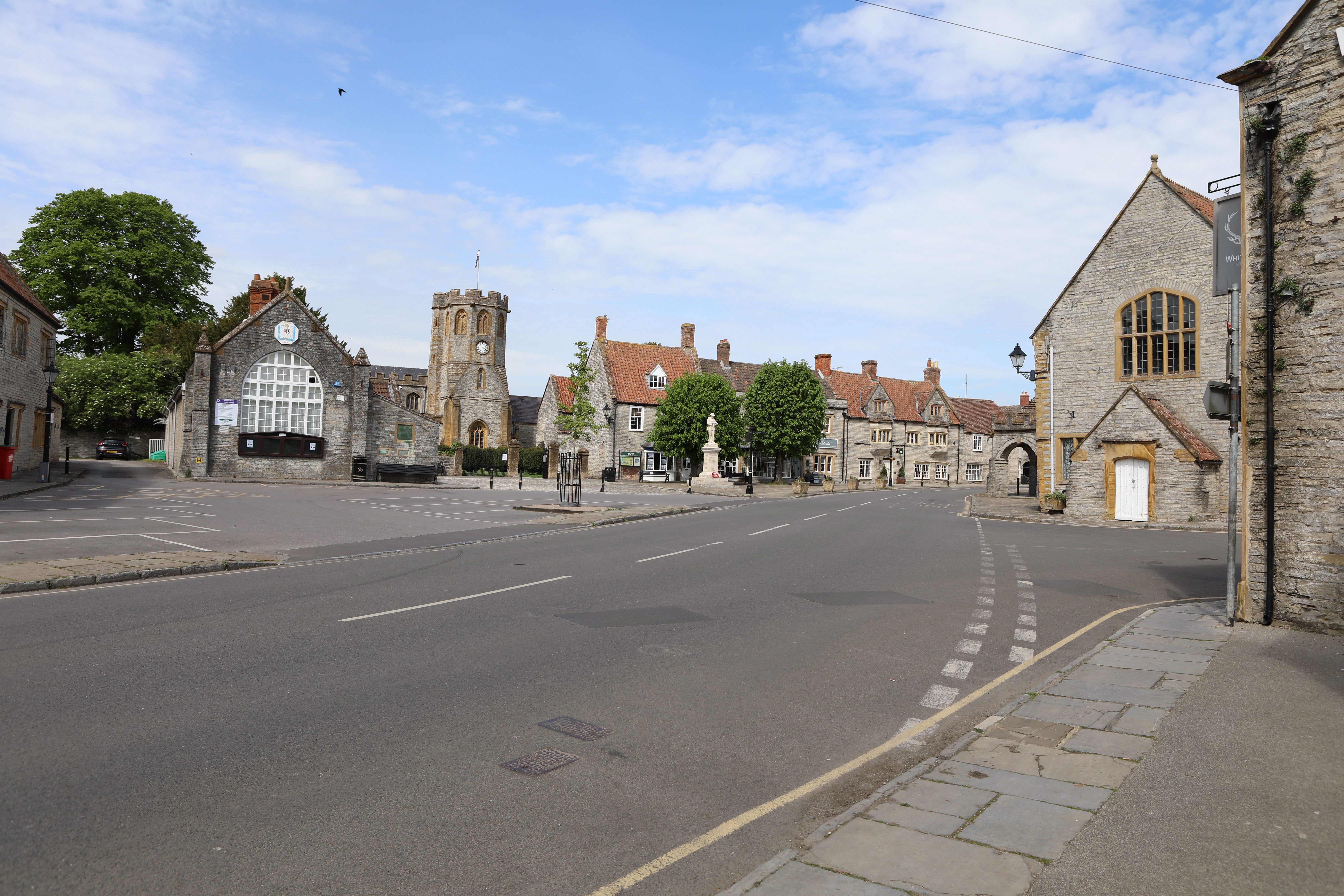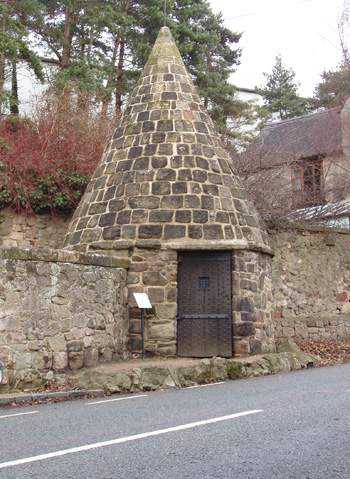|
Old Town Hall, Somerton
The Old Town Hall is a municipal building in the Market Place in Somerton, Somerset, England. The building, which is used as an arts centre, is a Grade II listed building. History The building was originally commissioned as a shambles, i.e. a meat market, and the site chosen for it was to just to the south of the Butter Cross which itself was rebuilt in 1673. The lord of the manor at the time was Sir Stephen Fox of Redlynch Park, courtier to King Charles II, and the "richest commoner in the three kingdoms". The shambles was designed in the neoclassical style, built in rubble masonry with hamstone dressings and formed part of a trio of new buildings, including a tolsey house (i.e. a building for administering market tolls) and a storage shed (used for storing sheep hurdles), which were provided for the use of local merchants under a lease of markets and fairs, in 1688. The design involved a rectangular two-storey building; the west end featured a gabled porch on the groun ... [...More Info...] [...Related Items...] OR: [Wikipedia] [Google] [Baidu] |
Somerton, Somerset
Somerton ( ) is a town and civil parish in the English county of Somerset. It gave its name to the county and was briefly, around the start of the 14th century, the county town, and around 900 was possibly the capital of Wessex. It has held a weekly market since the Middle Ages, and the main square with its market cross is today popular with visitors. Situated on the River Cary, approximately north-west of Yeovil, Somerton has its own town council serving a population of 4,697 as of 2011. Residents are often referred to locally as Somertonians. The civil parish includes the hamlets of Etsome, Hurcot, Catsgore, and Catcombe. Archaeological remains at Somerton are evidence of a Celtic settlement. The discovery of a high status cemetery in 2019, suggests that these local people adopted a more Roman lifestyle. During the Anglo-Saxon era, Somerton was an important political and commercial centre. After the Norman conquest of England the importance of the town declined, despite bei ... [...More Info...] [...Related Items...] OR: [Wikipedia] [Google] [Baidu] |
Nikolaus Pevsner
Sir Nikolaus Bernhard Leon Pevsner (30 January 1902 – 18 August 1983) was a German-British art historian and architectural historian best known for his monumental 46-volume series of county-by-county guides, ''The Buildings of England'' (1951–74). Life Nikolaus Pevsner was born in Leipzig, Saxony, the son of Anna and her husband Hugo Pevsner, a Russian-Jewish fur merchant. He attended St. Thomas School, Leipzig, and went on to study at several universities, Munich, Berlin, and Frankfurt am Main, before being awarded a doctorate by Leipzig in 1924 for a thesis on the Baroque architecture of Leipzig. In 1923, he married Carola ("Lola") Kurlbaum, the daughter of distinguished Leipzig lawyer Alfred Kurlbaum. He worked as an assistant keeper at the Dresden Gallery between 1924 and 1928. He converted from Judaism to Lutheranism early in his life. During this period he became interested in establishing the supremacy of German modernist architecture after becoming aware of Le ... [...More Info...] [...Related Items...] OR: [Wikipedia] [Google] [Baidu] |
City And Town Halls In Somerset
A city is a human settlement of notable size.Goodall, B. (1987) ''The Penguin Dictionary of Human Geography''. London: Penguin.Kuper, A. and Kuper, J., eds (1996) ''The Social Science Encyclopedia''. 2nd edition. London: Routledge. It can be defined as a permanent and densely settled place with administratively defined boundaries whose members work primarily on non-agricultural tasks. Cities generally have extensive systems for housing, transportation, sanitation, utilities, land use, production of goods, and communication. Their density facilitates interaction between people, government organisations and businesses, sometimes benefiting different parties in the process, such as improving efficiency of goods and service distribution. Historically, city-dwellers have been a small proportion of humanity overall, but following two centuries of unprecedented and rapid urbanization, more than half of the world population now lives in cities, which has had profound consequences for g ... [...More Info...] [...Related Items...] OR: [Wikipedia] [Google] [Baidu] |
Giles Fox-Strangways, 6th Earl Of Ilchester
Giles Stephen Holland Fox-Strangways, 6th Earl of Ilchester (31 May 1874 – 29 October 1959), styled Lord Stavordale until 1905, was a British peer and philanthropist. Background and education Fox-Strangways was the eldest child of Henry Fox-Strangways, 5th Earl of Ilchester, by Lady Mary Eleanor Anne Dawson, daughter of Richard Dawson, 1st Earl of Dartrey. He was educated at Eton and Christ Church, Oxford and was an officer in the Coldstream Guards, promoted to Lieutenant 5 March 1902. Career For Dorsetshire Giles was justice of the peace and deputy lieutenant; he also received a Legion of Honour and O.B.E. in 1919. From 1922 to 1959, Lord Ilchester was a Trustee of the National Portrait Gallery (and Chairman from 1941–59) and of the British Museum from 1931–59. He was also a Member of the Royal Commission on the Historical Monuments of England from 1939–59 (and Chairman from 1943–59), President of the London Library from 1940–52, President of the Royal Literary F ... [...More Info...] [...Related Items...] OR: [Wikipedia] [Google] [Baidu] |
Magistrates' Court
A magistrates' court is a lower court where, in several jurisdictions, all criminal proceedings start. Also some civil matters may be dealt with here, such as family proceedings. Courts * Magistrates' court (England and Wales) * Magistrate's Court of Jersey * Magistrates' court (Hong Kong) * Magistrate's courts of Israel * Magistrate's court (South Africa) * District Court (New Zealand), replaced magistrate's courts in 1980 * District Court (Ireland), the main court of summary jurisdiction in Ireland * Magistrate's court (Russia) * Magistrate's court (Sri Lanka) Australian courts * Magistrates Court of the Australian Capital Territory * Magistrates court (Northern Territory) * Magistrates Court of Queensland * Magistrates Court of South Australia * Magistrates Court of Tasmania * Magistrates' Court of Victoria * Magistrates Court of Western Australia * Local Court of New South Wales * Federal Circuit Court of Australia (initially the Federal Magistrate's Court of Australia. T ... [...More Info...] [...Related Items...] OR: [Wikipedia] [Google] [Baidu] |
Sir Alexander Hood, 2nd Baronet
{{England-Conservative-UK-MP-1790s-stub ...
Sir Alexander Hood, 2nd Baronet (5 July 1793 – 7 March 1851), was an English Conservative Party politician. He was a Member of Parliament (MP) for Somerset West from 1847 until his death in 1851. References 1793 births 1851 deaths Baronets in the Baronetage of the United Kingdom UK MPs 1847–1852 Conservative Party (UK) MPs for English constituencies Alexander Alexander is a male given name. The most prominent bearer of the name is Alexander the Great, the king of the Ancient Greek kingdom of Macedonia who created one of the largest empires in ancient history. Variants listed here are Aleksandar, Al ... [...More Info...] [...Related Items...] OR: [Wikipedia] [Google] [Baidu] |
Member Of Parliament (United Kingdom)
In the United Kingdom, a member of Parliament (MP) is an individual elected to serve in the House of Commons of the Parliament of the United Kingdom. Electoral system All 650 members of the UK House of Commons are elected using the first-past-the-post voting system in single member constituencies across the whole of the United Kingdom, where each constituency has its own single representative. Elections All MP positions become simultaneously vacant for elections held on a five-year cycle, or when a snap election is called. The Fixed-term Parliaments Act 2011 set out that ordinary general elections are held on the first Thursday in May, every five years. The Act was repealed in 2022. With approval from Parliament, both the 2017 and 2019 general elections were held earlier than the schedule set by the Act. If a vacancy arises at another time, due to death or resignation, then a constituency vacancy may be filled by a by-election. Under the Representation of the People Act 198 ... [...More Info...] [...Related Items...] OR: [Wikipedia] [Google] [Baidu] |
Labourer's Friend Society
The Labourer's Friend Society was a society founded by Lord Shaftesbury in the United Kingdom in 1830 for the improvement of working class conditions. This included the promotion of allotment of land to labourers for "cottage husbandry" that later became the allotment movement, which the Society campaigned for after the Swing riots of 1830 as "the most plausible remedy for the social problems of the countryside". It published the ''Labourer's Friend Magazine'', and in 1844 changed its title to the Society for Improving the Condition of the Labouring Classes, becoming the first Model Dwellings Company in 1844. The Society received support from many influential figures of the time, including Montagu Burgoyne, Sir William Miles, Mary Ann Gilbert and Lord Ashley, who was the primary influence behind the transition of the Society into a more powerful body. The new Society had the patronage of Queen Victoria, the Prince Consort as president and Ashley as chairman. The company's arch ... [...More Info...] [...Related Items...] OR: [Wikipedia] [Google] [Baidu] |
Village Lock-up
A village lock-up is a historic building once used for the temporary detention of people in England and Wales, mostly where official prisons or criminal courts were beyond easy walking distance. Lockups were often used for the confinement of drunks, who were usually released the next day, or to hold people being brought before the local magistrate. The archetypal form comprises a small room with a single door and a narrow slit window, grating or holes. Most lock-ups feature a tiled or stone-built dome or spire as a roof and are built from brick, stone and/or timber. Such a room was built in many shapes; many are round, which gives rise to a sub-description: the punishment or village round-house. Village lock-ups, though usually freestanding, were often attached to walls, tall pillar/tower village crosses or incorporated into other buildings. Varying in architectural strength and ornamentation, they were all built to perform the same function. Nicknames and forms They have acqui ... [...More Info...] [...Related Items...] OR: [Wikipedia] [Google] [Baidu] |
Transom (architecture)
In architecture, a transom is a transverse horizontal structural beam or bar, or a crosspiece separating a door from a window above it. This contrasts with a mullion, a vertical structural member. Transom or transom window is also the customary U.S. word used for a transom light, the window over this crosspiece. In Britain, the transom light is usually referred to as a fanlight, often with a semi-circular shape, especially when the window is segmented like the slats of a folding hand fan. A prominent example of this is at the main entrance of 10 Downing Street, the official residence of the British prime minister. History In early Gothic ecclesiastical work, transoms are found only in belfry unglazed windows or spire lights, where they were deemed necessary to strengthen the mullions in the absence of the iron stay bars, which in glazed windows served a similar purpose. In the later Gothic, and more especially the Perpendicular Period, the introduction of transoms became common i ... [...More Info...] [...Related Items...] OR: [Wikipedia] [Google] [Baidu] |
Neoclassical Architecture
Neoclassical architecture is an architectural style produced by the Neoclassical movement that began in the mid-18th century in Italy and France. It became one of the most prominent architectural styles in the Western world. The prevailing styles of architecture in most of Europe for the previous two centuries, Renaissance architecture and Baroque architecture, already represented partial revivals of the Classical architecture of ancient Rome and (much less) ancient Greek architecture, but the Neoclassical movement aimed to strip away the excesses of Late Baroque and return to a purer and more authentic classical style, adapted to modern purposes. The development of archaeology and published accurate records of surviving classical buildings was crucial in the emergence of Neoclassical architecture. In many countries, there was an initial wave essentially drawing on Roman architecture, followed, from about the start of the 19th century, by a second wave of Greek Revival architec ... [...More Info...] [...Related Items...] OR: [Wikipedia] [Google] [Baidu] |
Mullion
A mullion is a vertical element that forms a division between units of a window or screen, or is used decoratively. It is also often used as a division between double doors. When dividing adjacent window units its primary purpose is a rigid support to the glazing of the window. Its secondary purpose is to provide structural support to an arch or lintel above the window opening. Horizontal elements separating the head of a door from a window above are called transoms. History Stone mullions were used in Armenian, Saxon and Islamic architecture prior to the 10th century. They became a common and fashionable architectural feature across Europe in Romanesque architecture, with paired windows divided by a mullion, set beneath a single arch. The same structural form was used for open arcades as well as windows, and is found in galleries and cloisters. In Gothic architecture windows became larger and arrangements of multiple mullions and openings were used, both for structure and ... [...More Info...] [...Related Items...] OR: [Wikipedia] [Google] [Baidu] |






.jpg)
_-_facade_on_Piazza_dei_signori.jpg)